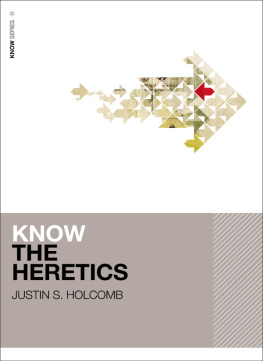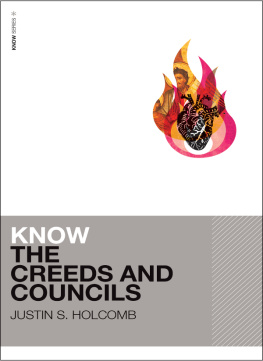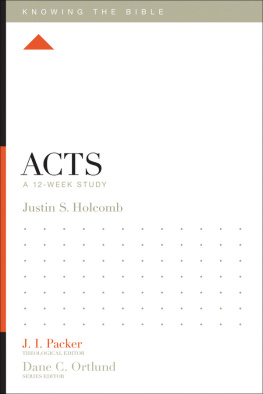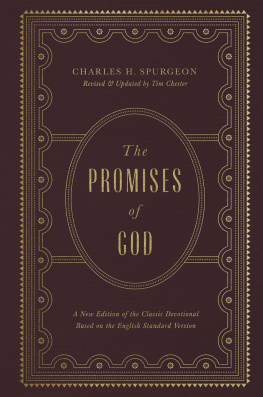I am grateful for the research assistance from Kathy Larson, Ellen Ceely, and Steve Rustin. I would like to thank Zach Williams and the Reverend Dr. Dave Johnson for their wise input and Andy McGuire and Hannah Ahlfield at Bethany House for their support of this project.
Introduction
The goal of this devotional is to expand upon a simple yet elegant line from George Herbert that captures two essential features of the Christian teaching about Jesus Christ: In Christ two natures met to be thy cure.
The first is the person of Jesus Christ, who is fully God and fully man. At the Fathers bidding and by the power of the Holy Spirit, the Son assumed human nature at the incarnation: The Word became flesh and dwelt among us (John 1:14). The divine nature and human nature met in the one person of Jesus Christ.
The second is the work of Christ. The Lord took on the form of a servant to be our cure. By subjecting himself to the frailties and temptations of our condition and yet remaining without sin, He condemned sin in the flesh, undoing the consequences of sin. In His incarnation, obedience, death, resurrection, ascension, and future return, Jesus Christ accomplished redemption.
Let us ponder the astonishing truth that, as the Nicene Creed eloquently states, the Son of God for us and for our salvation came down from heaven and became incarnate by the Holy Spirit and of the Virgin Mary, and was made man. The Nicene Creed, the cornerstone of orthodox Christian belief, attaches saving significance not only to Christs death and resurrection but also to His incarnation and birth.
This book celebrates that Jesus Christ is God with us and God for us. It explores the abundance, capacity, and immensity of Christs tender and powerful love for you. It explores His sovereign rule as Lord and King. We will see that the person and work of Christ have very personal implications for you. Those same implications are also comprehensive for all creation. The Lord delights in showing mercy to you, and He is making all things new.
The selected texts in this devotional display the wonder of the person of Christ, the fullness of His marvelous works, and the tenderness of the very heart of God incarnate. These excerpts from classic Christian writers, theologians, and pastors have been gently edited to enhance their readability.
George Herbert, from The Temple (1633). For more on the two essential features of the Christian teaching about Christ, see Scott R. Swain, In Christ two natures met to be thy cure, Modern Reformation 24:6 (2015), 2023.
DAY
1
Matthew 1:23: They shall call his name Immanuel (which means, God with us).
It was of supreme importance that He who was to be our Mediator should be both true God and true man. If the necessity be inquired into, it was not what is commonly termed simple or absolute but flowed from the divine decree on which the salvation of humanity depended. What was best for us our most merciful Father determined. Our iniquities, like a cloud intervening between Him and us, having utterly alienated us from the kingdom of heaven, none but a person reaching to Him could be the medium of restoring peace. But who could reach to Him? Could any of the sons of Adam? All of them shuddered at the sight of God. Could any of the angels? They had need of a superior, by connection with whom they might adhere to God entirely and inseparably. What then? The case was certainly desperate if the Godhead himself did not descend to us, it being impossible for us to ascend to Him. Thus, the Son of God took it upon himself to become our Emmanuel, i. e. , God with us; and in such a way, that by mutual union, His divinity and our nature might be combined; otherwise, neither was the proximity near enough, nor the affinity strong enough, to give us hope that God would dwell with us; so great was the divide between our lost state and the spotless purity of God.
Had humans remained free from all corruption, they were of too humble a condition to approach God without a Mediator. What, then, of humanitys true state, when by fatal flaw they were condemned to death and hell, defiled by sin, made loathsome through the curse, in complete and utter despair? It is not without cause, therefore, that Paul, when he sets forth Christ as the Mediator, distinctly declares Him to be man. For there is one God, he says, and there is one mediator between God and men, the man Christ Jesus (1 Timothy 2:5). He might have called Him God, or called Him man; but because the Spirit, speaking through him, knew our infirmity, he provides for it by the most appropriate remedy: setting the Son of God familiarly before us as one of us.
JOHN CALVIN , Institutes of the Christian Religion , vol. 2, trans. Henry Beveridge (Edinburgh: The Calvin Translation Society, 1845), 23 ( Institutes , 2.12.1).
DAY
2
Matthew 9:36: When he saw the crowds, he had compassion for them, because they were harassed and helpless, like sheep without a shepherd.
Compassion is no doubt the emotion we would naturally expect to find most frequently attributed to Jesus, whose whole life was a mission of mercy, and whose ministry was so marked by deeds of generosity that it was summed up in the memory of His followers as a going through the land doing good (Acts 10:38). In fact, this is the emotion that is most frequently attributed to Him. The term compassion first appears in common use in this sense in the Synoptic Gospels.
The divine mercy has been defined as that essential perfection in God whereby He pities and relieves the miseries of His creatures. It includes two parts: an internal movement of pity and an external act of kindness or generosity. It is the internal movement of pity that is emphasized when our Lord is said to be moved with compassion, as the term is sometimes excellently rendered in the English versions. In the appeals made to His mercy, a more external word is used; but it is this more internal word that is employed to express our Lords response to these appeals: the petitioners sought Him to take pity on them; His heart responded with a profound feeling of pity for them.
















